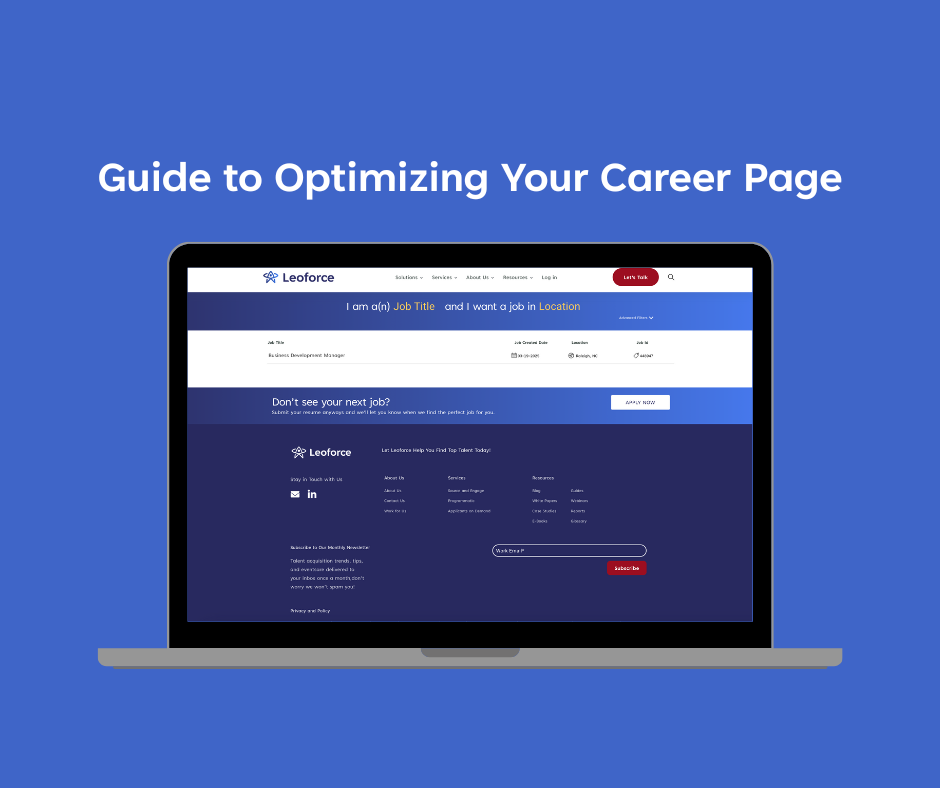Recruitment Database Essentials: Tips for Stronger Networks

In a highly competitive recruiting market, a well-organized recruitment database is essential for companies to effectively source and hire top talent. Essentially, a recruitment database tool plays a crucial role in streamlining the hiring process and building stronger networks of potential candidates.
According to recent statistics, over 98.8% of Fortune 500 companies utilize applicant tracking systems (ATS), demonstrating the widespread adoption of these tools among large enterprises. Additionally, 66% of large companies and 35% of small organizations rely on ATS to streamline their recruitment processes. Given these high adoption rates, it’s reasonable to assume that recruiting databases are also widely used by these companies as part of their ATS platforms.
A robust recruiter database empowers hiring teams to analyze data, identify trends, and make informed decisions to attract and retain the best talent. In this article, we’ll explore the importance of maintaining a comprehensive recruitment database and provide valuable tips for optimizing its effectiveness in sourcing and hiring top candidates.
What is a recruitment database?
Also known as a candidate or applicant database, it serves as a centralized repository of candidate information. It includes resumes, contact details, application statuses, and interaction notes, facilitating efficient management of the hiring process for recruiters and hiring managers.
Benefits of a recruitment database
- Reduced time to fill: A recruitment database enables recruiters to quickly and efficiently identify suitable candidates from a pool of past applicants, reducing the time required to fill open positions. This allows recruiters to expedite the hiring process and fill roles more efficiently.
- Improved candidate experience: According to CareerBuilder, 60% of candidates drop off in the middle of filling job applications because of the complexity or length of application forms. Ergo, bad candidate experience. By leveraging a recruitment database, candidates no longer need to repeatedly enter their information for future applications. This enhances the candidate experience by eliminating redundant tasks and simplifying the application process, leading to increased satisfaction among applicants.
- Enhanced data-driven hiring: Talent databases empower hiring teams to analyze metrics and identify successful candidate sourcing patterns. By harnessing recruitment analytics, organizations can make informed decisions to optimize their hiring processes, attract top talent, and improve overall hiring efficiency.
- Compliance: Maintaining a recruitment database ensures organizations remain compliant with legal regulations and guidelines. By documenting recruitment activities and storing historical data, companies can demonstrate transparency and mitigate risks associated with non-compliance.
Assessing current database needs
Before acquiring or establishing a recruitment database, it’s essential to assess the current database landscape. This process involves evaluating various factors such as job information, required qualifications, critical positions, and concrete objectives.
- Job information: Gathering comprehensive job information is the initial step in assessing database needs. This includes understanding specific job requirements, responsibilities, and skills needed for each position ensuring the database reflects the organization’s hiring needs.
- Required qualifications: Identifying the required qualifications for each role involves specifying education, experience, certifications, and skills necessary for successful job performance. By defining required qualifications upfront, recruiters can filter candidates more effectively and ensure alignment between candidate profiles and job requirements within the database.
- Critical positions: Certain roles may have a significant impact on business operations or be particularly challenging to fill. As per Jobvite’s 2022 Quarterly Insights report, finding individual contributor roles (69%) and managerial positions (52%) are identified as the most challenging. By identifying these critical positions, organizations can allocate resources effectively and focus on sourcing and nurturing candidates for these key roles.
- Concrete objectives: Establishing concrete objectives for recruitment efforts is fundamental to aligning database strategies with broader organizational goals. These objectives may include reducing time-to-fill, improving candidate quality, increasing diversity in hiring, or enhancing overall hiring efficiency through recruitment analytics.
Conducting an audit
Now that we’ve understood the importance of maintaining a well-organized recruitment database, it’s equally important to conduct regular database audits to ensure its effectiveness. Here’s how recruiters can systematically assess or audit a database:
- Review current database: Recruiters should begin by meticulously reviewing the current recruitment database. This involves inspecting every aspect to identify any duplicate entries or outdated information. By conducting this review, recruiters can ensure data accuracy and integrity.
- Categorize candidates: Once the review is complete, recruiters should categorize candidates based on their skills, experience, and other relevant factors. This systematic categorization allows recruiters to organize the database effectively, facilitating streamlined candidate searches and selection processes.
- Analyse metrics: Recruiters need to delve into the recruitment analytics to analyze key metrics such as time-to-hire and candidate rejection rates. By examining these metrics, recruiters can gain insights into the efficiency and effectiveness of the recruitment database. This analysis enables recruiters to identify areas for improvement and optimization.
Identifying pain points
As recruiters delve into the data audit process of their recruitment software, it’s important to identify any pain points within the system. Here are some common issues to watch out for:
- Outdated information: Note any outdated information within the database, such as old resumes or contact details. Keeping this information up to date is required for effective candidate management.
- Inefficient search function: Pay attention to any difficulties encountered when searching for candidates or specific information within the recruitment software. An efficient search function is essential for saving time and improving productivity.
- Slow processing: If the recruitment software is slow to process requests or load data, it can significantly impact recruitment efficiency. Identifying and addressing slow processing issues is essential for streamlining the hiring process.
- Lack of specific features: Take note of any specific features or functionalities that are lacking in the recruitment software. These features could include advanced search filters, integration with other tools, or customizable reporting options.
- Data validity: Ensuring data validity is important for making informed hiring decisions and maintaining compliance with data protection regulations.
- Data integration: Limited integration can hinder workflow efficiency and lead to data silos, making it challenging to access and utilize candidate information effectively.
- Data analytics: Recruiters need to assess the database’s data analytics capabilities to determine its effectiveness in providing actionable insights for recruitment strategies.
- Data security: Ensuring robust data security measures are in place is crucial for protecting sensitive candidate information and maintaining trust with applicants.
Setting objectives for improvement
To enhance the effectiveness of the recruitment database, setting clear objectives is essential. Here’s how recruiters can define goals and select relevant Key Performance Indicators (KPIs) for improvement:
- Defining goals: Whether it’s improving speed, enhancing candidate experience, or optimizing candidate sourcing, clarifying S.M.A.R.T goals is necessary for focused improvement efforts.
- Set clear targets: Once the goals are defined, set clear and measurable targets for improvement. These targets should be specific, measurable, achievable, relevant, and time-bound (SMART) to ensure accountability and track progress effectively.
- Define Key Performance Indicators (KPIs): KPIs such as time-to-fill, the number of qualified candidates in the database, and candidate satisfaction scores can provide valuable insights into the effectiveness of the recruitment database and the overall hiring process. Here are some key performance indicators to consider for your recruitment database:
- Time to fill: Measuring the time taken to fill a job vacancy from the moment it’s opened until the offer is accepted.
- Candidate experience rate: Evaluating the overall experience of candidates throughout the recruitment process.
- Quality of hire: Assessing the quality of candidates hired based on their performance, retention rates, and contribution to the organization’s success.
- Sourcing efficiency: Tracking the effectiveness of different sourcing channels in attracting qualified candidates.
- Retention rate: Measuring the percentage of new hires who remain with the organization for a specified period.
- Cost per hire: Calculating the total cost incurred in the recruitment process divided by the number of hires made within a specific period.
Streamlining the recruitment process
Streamlining the recruitment process is essential for efficiency and productivity. Here are two key strategies to achieve this:
Automation tools
Leveraging automation tools can significantly reduce manual tasks and streamline workflows in the recruitment process. For instance, resume parsing software automatically extracts relevant information from resumes, eliminating the need for manual data entry and saving valuable time for recruiters.
Additionally, automated email communications can be used to keep candidates informed about their application status, schedule interviews, and provide updates throughout the hiring process. By implementing workflow automation tools, recruiters can focus their time and efforts on more strategic tasks, such as candidate engagement and relationship building.
Applicant Tracking Systems (ATS)
ATS software can streamline recruitment processes by centralizing candidate data, enabling recruiters to easily track and manage applicants’ progress through each stage of the hiring process. Moreover, an ATS facilitates team collaboration by allowing recruiters and hiring managers to share feedback, notes, and evaluations in one centralized location.
Enhancing candidate experience
Ensuring a positive candidate experience is paramount in attracting top talent. Here’s how to elevate the candidate journey:
- User-friendly interface: One of the key aspects of enhancing the candidate experience is ensuring that the application process is smooth and user-friendly across all devices. Candidates should be able to easily navigate through the application process without encountering any hurdles or complications.
- Personalized communication: While automation can streamline the communication process, it’s important to ensure that messages are personalized to each candidate. Automated but tailored communication can be used for various communication purposes, such as application confirmations, status updates, and rejections.
Leveraging technology for sourcing candidates
Leveraging recruiting technology is essential for effective candidate sourcing. Here are three strategies to optimize a recruiting manager’s sourcing efforts:
- Data enrichment tools: Data enrichment tools help find additional candidate information, such as social profiles and online portfolios, providing valuable insights into candidates’ skills, experiences, and interests allowing recruiters to tailor their outreach efforts and better engage with potential candidates.
- Boolean search: Boolean search allows recruiters to narrow down their candidate search by specifying specific skills, experience, or qualifications required for the role. Recruiters can efficiently sift through vast candidate databases, job boards, and social platforms to identify the most relevant candidates for their open positions.
- Sourcing extensions: Explore browser extensions designed to streamline the candidate sourcing process. These extensions can help uncover contact information, such as email addresses and phone numbers, directly from websites and social media platforms.
In conclusion, a robust recruitment database offers long-term benefits by streamlining hiring processes and enabling data-driven decisions, ultimately enhancing efficiency and candidate experiences. Recognizing its dynamic nature, regular reviews and updates are encouraged to ensure alignment with evolving organizational needs and industry trends. Leveraging a well-built database provides a competitive advantage by facilitating efficient talent acquisition processes, necessary for attracting and retaining top talent effectively.





